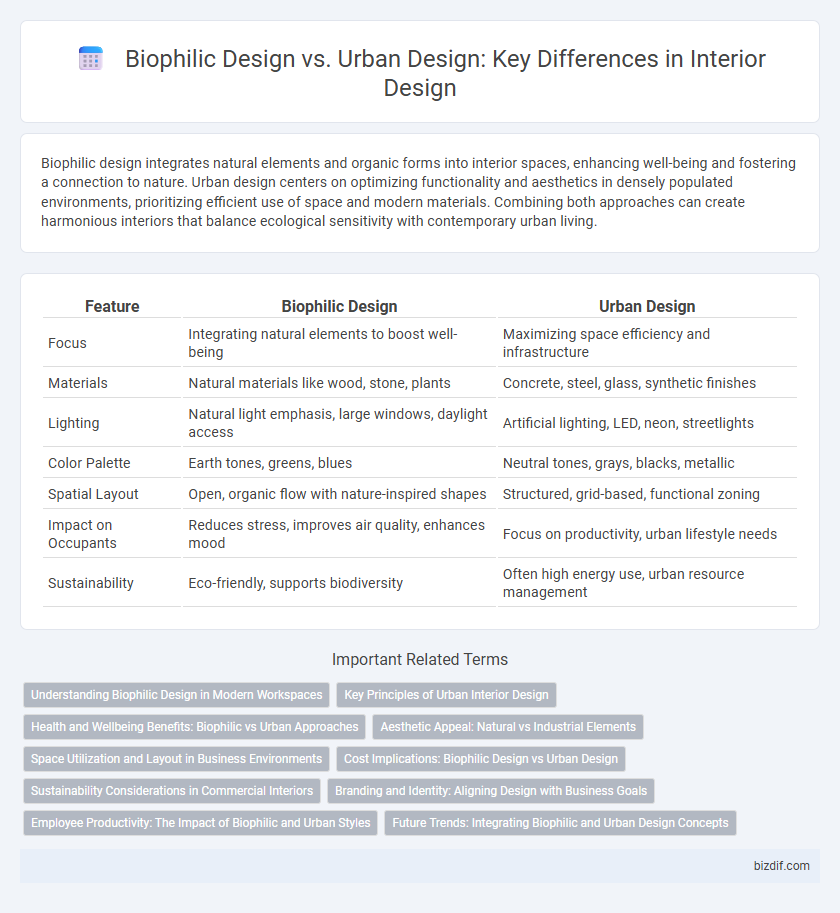Biophilic design integrates natural elements and organic forms into interior spaces, enhancing well-being and fostering a connection to nature. Urban design centers on optimizing functionality and aesthetics in densely populated environments, prioritizing efficient use of space and modern materials. Combining both approaches can create harmonious interiors that balance ecological sensitivity with contemporary urban living.
Table of Comparison
| Feature | Biophilic Design | Urban Design |
|---|---|---|
| Focus | Integrating natural elements to boost well-being | Maximizing space efficiency and infrastructure |
| Materials | Natural materials like wood, stone, plants | Concrete, steel, glass, synthetic finishes |
| Lighting | Natural light emphasis, large windows, daylight access | Artificial lighting, LED, neon, streetlights |
| Color Palette | Earth tones, greens, blues | Neutral tones, grays, blacks, metallic |
| Spatial Layout | Open, organic flow with nature-inspired shapes | Structured, grid-based, functional zoning |
| Impact on Occupants | Reduces stress, improves air quality, enhances mood | Focus on productivity, urban lifestyle needs |
| Sustainability | Eco-friendly, supports biodiversity | Often high energy use, urban resource management |
Understanding Biophilic Design in Modern Workspaces
Biophilic design in modern workspaces integrates natural elements such as plants, natural light, and organic materials to enhance employee well-being and productivity. This approach contrasts with urban design, which often emphasizes built environments, concrete structures, and maximized space efficiency, sometimes at the expense of human connection to nature. Incorporating biophilic principles reduces stress and improves creativity by reconnecting workers with natural surroundings within urban office settings.
Key Principles of Urban Interior Design
Key principles of urban interior design emphasize maximizing functional space, incorporating industrial materials, and creating flexible layouts that accommodate diverse activities. Integrating sustainable elements such as energy-efficient lighting and recycled materials supports environmental responsibility within urban settings. Contrast this with biophilic design, which prioritizes natural elements and connections to nature to enhance well-being.
Health and Wellbeing Benefits: Biophilic vs Urban Approaches
Biophilic design incorporates natural elements like greenery, natural light, and water features, which have been scientifically proven to reduce stress, enhance mood, and boost cognitive function. Urban design often prioritizes functionality and density, potentially increasing exposure to pollution and noise, which can negatively impact mental and physical health. Integrating biophilic principles into urban environments supports healthier lifestyles by improving air quality, promoting relaxation, and fostering social interaction.
Aesthetic Appeal: Natural vs Industrial Elements
Biophilic design emphasizes aesthetic appeal through the integration of natural elements like greenery, natural light, and organic textures, creating tranquil and inviting spaces. Urban design often incorporates industrial materials such as steel, concrete, and exposed brick, promoting a modern and raw visual style. The contrast between natural warmth and industrial sleekness defines the visual experience Unique to each design philosophy.
Space Utilization and Layout in Business Environments
Biophilic design in business environments emphasizes maximizing natural light, incorporating greenery, and creating open, fluid layouts that enhance employee well-being and productivity. Urban design prioritizes efficient space utilization through structured, compact layouts that optimize functionality and accommodate high foot traffic. Integrating biophilic elements into urban design can improve spatial quality while maintaining practical layout efficiency in commercial settings.
Cost Implications: Biophilic Design vs Urban Design
Biophilic design often incurs higher initial costs due to the integration of natural elements like indoor plants, natural light, and sustainable materials that require specialized installation and maintenance. Urban design, by contrast, typically involves more standardized materials and infrastructure, which can reduce upfront expenses but may increase long-term costs related to environmental impact and energy consumption. Considering cost implications, biophilic design can lead to savings over time through improved occupant well-being and reduced energy use, whereas urban design may prioritize budget constraints over holistic sustainability.
Sustainability Considerations in Commercial Interiors
Biophilic design in commercial interiors emphasizes sustainability by integrating natural elements such as plants, natural light, and organic materials to improve air quality and reduce energy consumption. Urban design often prioritizes functionality and density, which can lead to higher carbon footprints if sustainable materials and energy-efficient systems are not incorporated. Incorporating biophilic principles in urban commercial spaces enhances occupant well-being while advancing environmental sustainability goals through reduced resource use and increased biodiversity.
Branding and Identity: Aligning Design with Business Goals
Biophilic design enhances branding by integrating natural elements that foster emotional connections and promote wellness, aligning with business goals aimed at sustainability and customer loyalty. Urban design emphasizes structured, functional spaces that reflect the company's identity through modernity and accessibility, supporting brand recognition in fast-paced environments. Both approaches strategically influence brand perception by tailoring design elements to resonate with targeted audiences and reinforce core business values.
Employee Productivity: The Impact of Biophilic and Urban Styles
Biophilic design, incorporating natural elements such as plants, natural light, and organic materials, significantly enhances employee productivity by reducing stress and improving cognitive function. Urban design, characterized by concrete, steel structures, and minimal greenery, often leads to increased distractions and lower focus levels in workplace environments. Integrating biophilic elements within urban design can bridge these gaps, fostering a more stimulating and efficient workspace for employees.
Future Trends: Integrating Biophilic and Urban Design Concepts
Future trends in interior design emphasize the integration of biophilic and urban design concepts to create sustainable, health-enhancing environments within city settings. Incorporating natural elements such as living walls, natural light, and organic materials into urban interiors promotes psychological well-being and reduces stress, aligning with increasing consumer demand for eco-conscious spaces. Advanced technologies like smart lighting and green infrastructure enable seamless blending of nature with urban functionality, driving innovation in biophilic urban interior design.
Biophilic design vs Urban design Infographic

 bizdif.com
bizdif.com